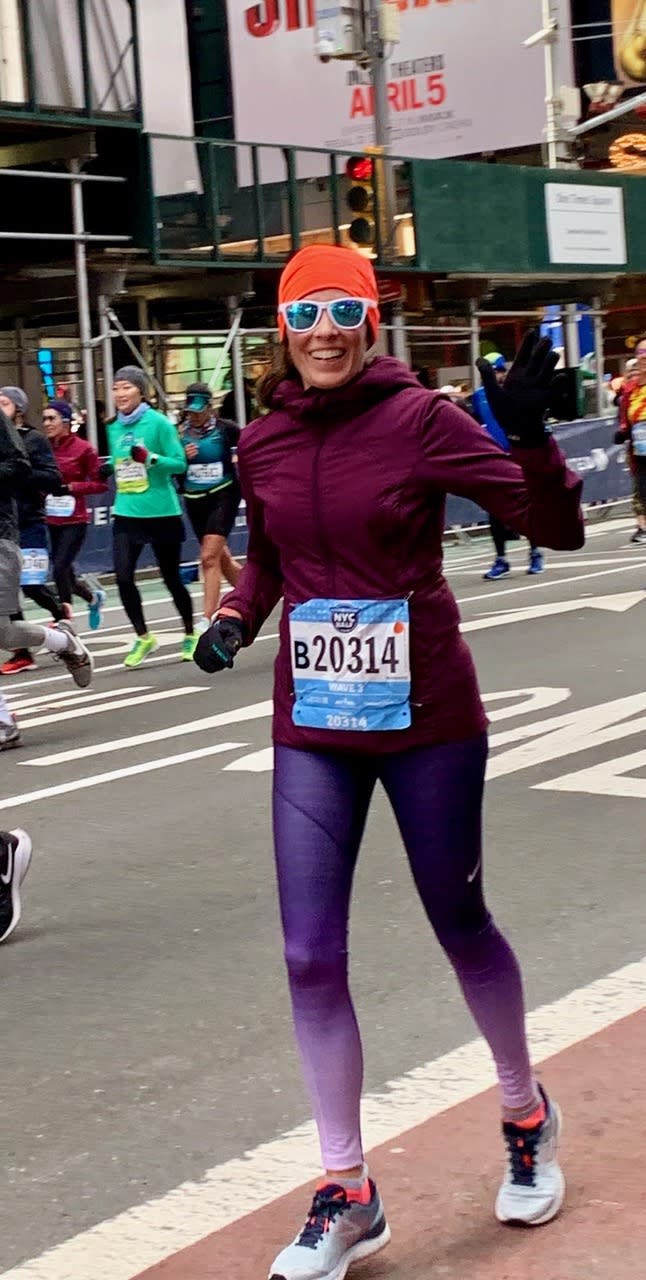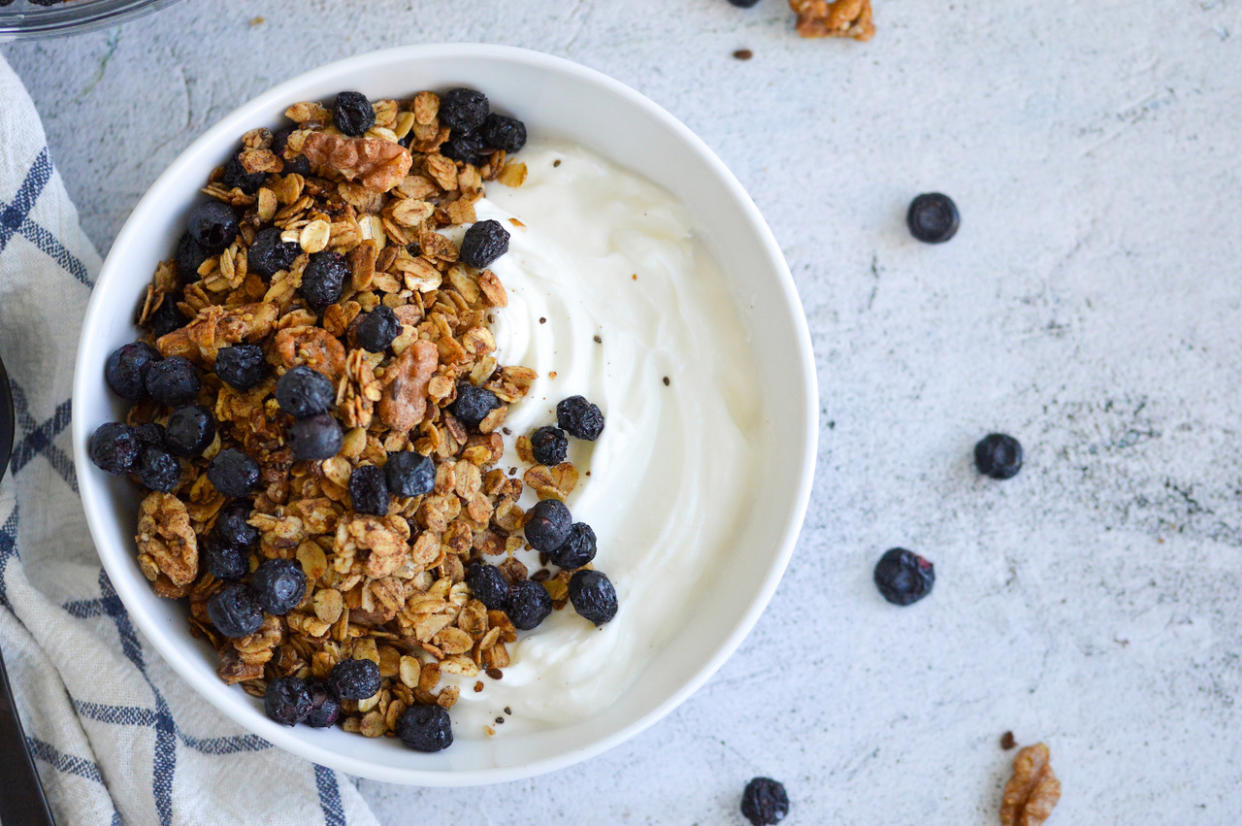Sports Nutrition Mistakes That Hurt My Marathon Training
I remember the exact moment I really understood the term “hitting the wall.” I was at mile 20 of the New York City Marathon and taking one more step felt impossible. I had trained for over four months, so I was physically and mentally prepared. But something failed me: my nutrition. It’s ironic because I’m a registered dietitian, and I studied sports nutrition in graduate school. But learning about fueling for sport and putting it into practice are two different things.
Something that was emphasized in my schooling is that sports nutrition is different than regular nutrition. The principles of sports nutrition don’t always coincide with the guidelines for healthy eating. For example, sports drinks are vilified as sugar-sweetened beverages that cause weight gain, but did you know they were actually formulated with a certain percentage of carbohydrates and electrolytes to keep athletes fueled and hydrated? Sports drinks aren’t necessary for everyone and knowing when and how to include them in a fitness regimen is just one of the nuances of sports nutrition.

I knew these principles during my marathon training in 2016, but I also fell victim to some common fueling mistakes. Since then, I’ve corrected my errors and have run many successful races. I’ve also worked with hundreds of people (and wrote a book on sports nutrition) to help as many athletes as possible avoid these common blunders.
I didn’t plan out my pre-workout fuel
An analogy that is often made in the sports nutrition world is that the body is like a car and food is the fuel that makes it move. In other words, energy levels are directly correlated to the amount of food you put in your system. Carbohydrates are the body’s main fuel source for exercise. The body utilizes two forms of carbs for energy: dietary carbs and carbs stored in the muscle and liver (called glycogen).
Dietary carbs are broken down within a few hours of eating, whereas protein and fat need longer to be digested. When eating within 60 minutes of a workout, a carb-rich snack is the best choice of fuel. But if you have 2-3 hours until your workout, a well-balanced meal with carbs, protein and a little bit of fat works well. That’s why I always say “what you eat depends on when you eat.”
During my marathon training, I had to be at work very early in the morning, so I ran in the afternoon or evening. I relied on what I ate for lunch or mid-afternoon snack to power me through my run. Sometimes I hadn’t eaten in hours, and I started my run with very little “gas in the tank.” Other times I ate foods that were technically healthy, but not great for fuel, like an avocado or a salad with tons of fiber (more on that later), and my stomach felt unsettled during the entire run.
I could’ve avoided all these fueling woes by properly planning a pre-workout snack 1-2 hours before a run. Foods like bananas, dates, granola or a handful of raisins are simple carb-rich snacks that are quickly digested and provide energy for a workout.

I ignored recovery nutrition
Looking back, this was the biggest flaw in my fueling. I had never run the long distances required with marathon training, so I didn’t know what to expect. After my long training runs, I actually wasn’t hungry. As a matter of fact, my stomach felt a little queasy.
Believe it or not, this happens to many athletes. After an intense workout, the body suppresses the production of a hormone called ghrelin, otherwise known as the “hunger hormone.” The result is a lack of hunger after vigorous activity. But that doesn’t mean you shouldn’t eat anything.
Recovery nutrition is crucial for a few reasons: It restores glycogen (the body’s form of stored carbs), aids in muscle repair and helps control hunger. In the first 1-2 hours after exercise, the body begins taking in food to facilitate muscle protein synthesis, and this recovery lasts for 24 hours.
Neglecting recovery nutrition usually results in excessive fatigue and hunger. This is what happened to me. Rather than eating within 1-2 hours after my run, I waited until my stomach felt normal and I was hungry enough to eat. But instead of feeling hungry, I was ravenous. My stomach was a bottomless pit and I ended up overeating. I was also tired on most of my training runs, but I figured this was normal during marathon training. I now realize that the fatigue was probably a sign of poor recovery nutrition.
Preventing this is simple: Eat some carbs and protein in the hour after a workout. If your stomach feels strange, opt for a recovery beverage like chocolate milk or a plant-based protein shake. Having something small will make a big difference later.
I watered down my sports drink
Sports drinks are a beneficial part of some training plans. After 45-60 minutes of endurance activity, the body needs to take in quick carbs to maintain energy levels. Sports drinks provide those digestible carbs, and they replace fluid and electrolytes lost in sweat. Plus, most sports drinks are isotonic, meaning they have similar glucose and sodium levels to the body, so they are able to be taken up quickly into the bloodstream.
I’m not a huge fan of the taste of sports drinks. When I was training, I thought that cutting a sports drink with water would be just as effective in keeping me hydrated. But science shows that a 6–8% carbohydrate concentration is ideal because it helps the body absorb the fluids more rapidly. By watering down my sports drink, I was tanking my energy levels and probably even dehydrating myself further.
I ate fiber at the wrong time
Don’t get me wrong, fiber is a beneficial part of the diet and most Americans don’t eat enough of it on a daily basis. But consuming high-fiber foods at the wrong time can wreak havoc on your stomach during training. For instance, eating beans for lunch before an evening workout or cruciferous veggies the night before an intense morning workout may cause the digestive system to move along faster than you want it to during exercise.
The constant motion of endurance activity jostles your stomach and sends foods through your digestive tract quicker than normal. Other factors, like hormones or dehydration, also move food through the digestive tract during exercise. Couple these normal physiological factors with high-fiber foods, and you’ve got a recipe for cramps, bloating and stomach pain during exercise.
That’s not to say you can’t eat fibrous foods while training, but it’s probably safer to include them in your post-workout meals. Everyone reacts differently to various foods, so it all comes down to trial and error with your fueling routine. Try certain foods to see how your stomach reacts to them.
My takeaway
As a dietitian, it’s embarrassing to admit some of these mistakes, especially since I knew better. After all, I’m educated in this field and I’m constantly reading science to stay up to date on the newest guidelines. But it shows that every single athlete (even the most informed ones!) makes mistakes in their fueling and training plans, and that’s okay. It’s about listening to your body, recognizing when something isn’t working, and adjusting your routine accordingly. I’m actually glad I made these mistakes so that I could learn and grow as a practitioner — and hopefully help others to avoid these common pitfalls.
This article was originally published on TODAY.com
